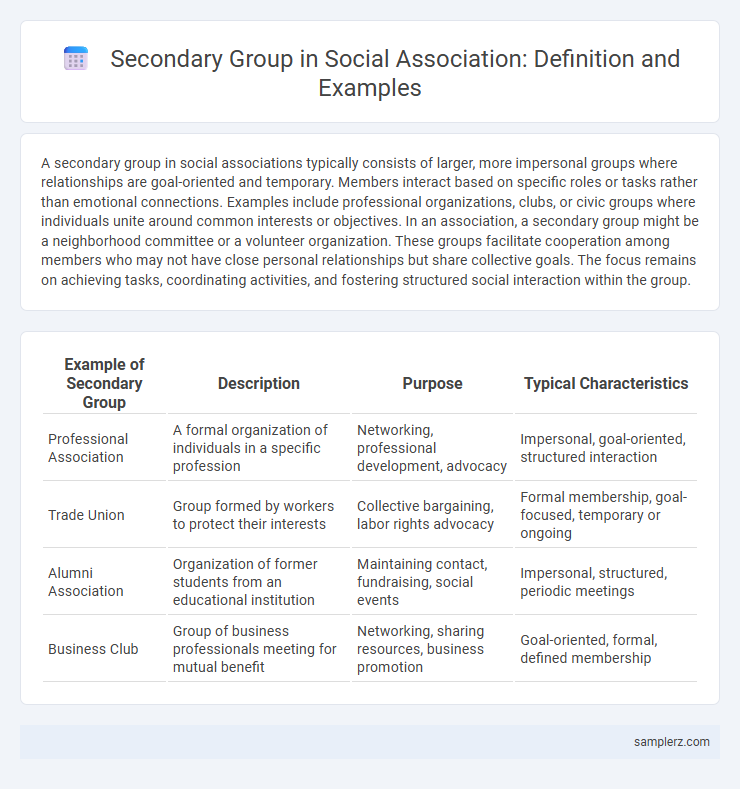A secondary group in social associations typically consists of larger, more impersonal groups where relationships are goal-oriented and temporary. Members interact based on specific roles or tasks rather than emotional connections. Examples include professional organizations, clubs, or civic groups where individuals unite around common interests or objectives. In an association, a secondary group might be a neighborhood committee or a volunteer organization. These groups facilitate cooperation among members who may not have close personal relationships but share collective goals. The focus remains on achieving tasks, coordinating activities, and fostering structured social interaction within the group.
Table of Comparison
| Example of Secondary Group | Description | Purpose | Typical Characteristics |
|---|---|---|---|
| Professional Association | A formal organization of individuals in a specific profession | Networking, professional development, advocacy | Impersonal, goal-oriented, structured interaction |
| Trade Union | Group formed by workers to protect their interests | Collective bargaining, labor rights advocacy | Formal membership, goal-focused, temporary or ongoing |
| Alumni Association | Organization of former students from an educational institution | Maintaining contact, fundraising, social events | Impersonal, structured, periodic meetings |
| Business Club | Group of business professionals meeting for mutual benefit | Networking, sharing resources, business promotion | Goal-oriented, formal, defined membership |
Understanding Secondary Groups in Social Associations
Secondary groups in social associations typically include professional organizations, clubs, and volunteer groups where members interact to achieve common goals. These groups prioritize formal roles, structured activities, and goal-oriented relationships rather than emotional or personal connections. Understanding secondary groups helps clarify how individuals collaborate within larger social frameworks to accomplish specific tasks or interests.
Key Characteristics of Secondary Group Associations
Secondary group associations typically consist of large, impersonal networks formed around specific goals or activities, such as professional organizations or volunteer groups. Members interact formally with limited emotional depth and rely on structured roles and rules to guide behavior. These groups prioritize efficiency, task accomplishment, and shared interests over personal relationships.
Clubs as Examples of Secondary Social Groups
Clubs exemplify secondary social groups by bringing together individuals who share common interests or activities without intimate, personal bonds. Members typically interact in structured settings, focusing on specific goals or pursuits such as hobby clubs, sports clubs, or professional associations. These groups emphasize formal relationships and organized roles, distinguishing them from primary social groups like family or close friends.
Professional Organizations as Secondary Group Associations
Professional organizations serve as prime examples of secondary group associations, characterized by formal, goal-oriented relationships among members. These groups often include entities like the American Bar Association or the Institute of Electrical and Electronics Engineers, fostering networking, skill development, and industry standards. Interaction within professional organizations remains structured and task-driven rather than personal, highlighting their role as secondary social groups.
Educational Institutions and Their Role as Secondary Groups
Educational institutions serve as quintessential secondary groups by facilitating interaction among individuals who unite for the purpose of acquiring knowledge and skills. These institutions, including schools, colleges, and universities, establish structured environments where relationships are goal-oriented and less personal than primary groups. Through formal curricula and institutional roles, they promote social norms, discipline, and collaborative learning, underscoring their critical function in societal development.
Volunteer Groups: A Secondary Social Association
Volunteer groups serve as a prime example of secondary social associations, where members unite based on shared goals rather than close personal relationships. These groups facilitate cooperation among individuals who often have limited emotional ties but are committed to collective community service. The organizational structure and task-oriented focus distinguish volunteer groups from primary social groups, emphasizing their role in broader social networks.
Religious Societies as Secondary Group Examples
Religious societies function as secondary groups where members unite over shared beliefs and rituals rather than intimate, personal relationships. These groups organize community activities, charitable work, and worship services, emphasizing formal structure and roles. Their social interactions are goal-oriented, fostering a sense of collective identity without deep personal bonds.
Political Parties as Secondary Social Associations
Political parties serve as prime examples of secondary groups within social associations, characterized by formal structures and goal-oriented relationships. Members typically engage in organized activities such as campaigns, policy formulation, and voting processes, which emphasize collective objectives over personal bonds. These associations foster social networks that influence political behavior and public decision-making on a broad societal scale.
Sports Teams as Forms of Secondary Groups
Sports teams exemplify secondary groups as they are formed based on shared goals and organized activities rather than personal relationships. Members interact primarily through structured events like practices, games, and competitions, emphasizing task-oriented collaboration. These groups foster social cohesion through teamwork and collective achievement, representing key dynamics of secondary group associations.
Online Communities as Modern Secondary Associations
Online communities serve as quintessential examples of modern secondary groups, characterized by formal interactions centered around shared interests rather than personal relationships. Members engage through digital platforms like forums, social media groups, or specialized apps, facilitating collaboration, information exchange, and support networks. These virtual associations exhibit goal-oriented behavior typical of secondary groups, emphasizing collective participation over intimate bonds.

example of secondary group in association Infographic
 samplerz.com
samplerz.com